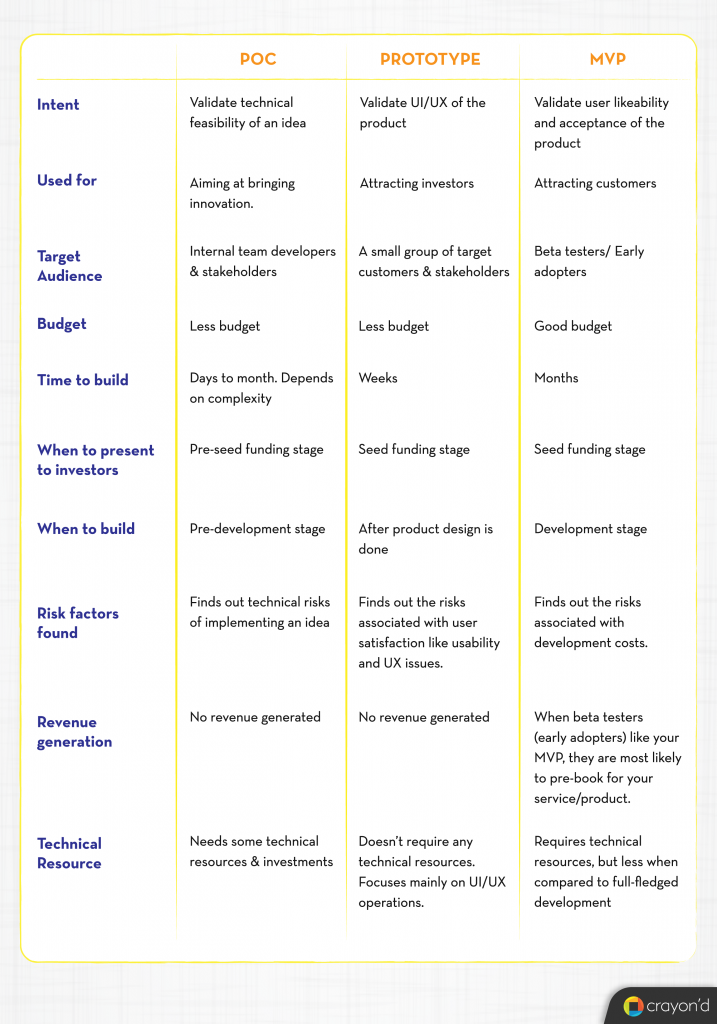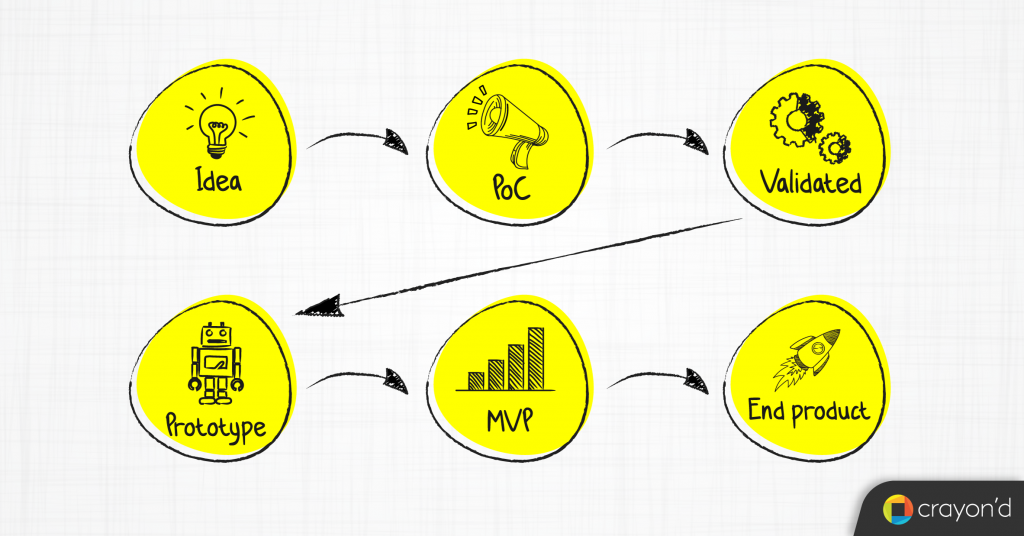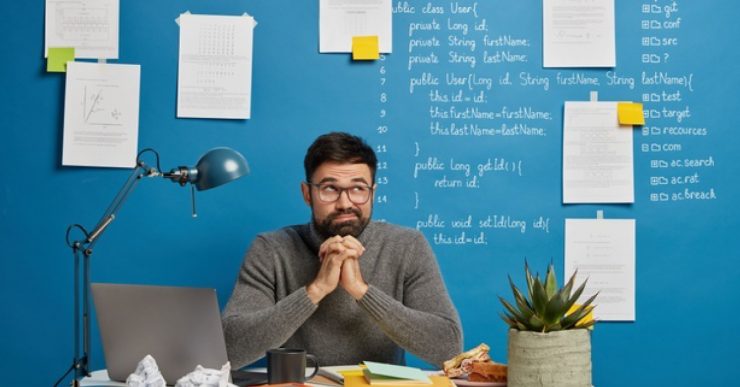Product success relies on many factors. These factors are spread across the entire lifecycle of a product.
All the stages beginning with idea validation to product development needs to be carefully planned. If the idea is not validated properly the chances that a product will fail.
Likewise, when you need to have the right strategies in place for development phases. Irrespective of these, you need to validate what you are developing with your users.
To help you with that, you have three approaches, Proof of Concept, Prototypes, and MVP. These three are often confused by the businesses for their purpose and time of usage.
Here, we will discuss in detail how they differ from each other and how to choose the right approach for your product.
MVP: Goal and benefits
Minimum Viable Product, also known as MVP is a minimal version of a product built with just the key features that satisfy the purpose of the product. MVP is fully functional.
The goal of an MVP: Launch, gain user feedback and iterate to improve the product.
Benefits of MVP
- Early feedback
- It’s obvious that you have ideated and developed your product based on user research data. But the development process is always influenced by business objectives and ideas from multiple teams. So, until the users lay their hands on your product and use it, you will never know the hidden flaws.
- Imagine your users finding flaws with your product after the actual release. This damages the reputation of your brand. But that’s not the case with MVP. Here, there is always room and chance for improvements. MVP helps you get early feedback from target users and work on the issues. MVP paves way for refining your product.
- Early relationship with users
- Once you launch your MVP, you seek beta testers to test it. These beta testers usually belong to the early adopters’ group. If your MVP impresses them, there are high chances that they become your customer.
- It doesn’t stop with that. Most beta testers are tech enthusiasts. And when they find something great, they love to talk about it to other people. Through this, they can spread the word about your product. This helps in bringing even more customers.
- Hence with MVP, you get to have a good relationship with your users, even before they become one.
- Quick to Market
- Product ideas are always born out of user agonies. This means that there are high chances for someone else to have an idea the same as yours.
- Often the first to market is considered original and have more chances to win. You can build the MVP real quick, launch it in the market to gain feedback. And hence, MVP is a way for you to keep ahead and get established in the market earlier.
- Lower-cost
- The principle of MVP is to stick to the core features alone.
- The focus is only on the important features of the product that are sufficient to solve a user’s problem. This reduces the complexity and the need for sophisticated coding. All of these results in lower costs.
- Once your MVP is validated, you can keep adding more features, in the coming days. Since the cost is spread over time, it reduces the burden of finances.
- Reduced risks
- Suppose you are releasing a product developed with a whole package of features and it ends up that your users don’t like it. This brings a huge loss and risk to your investment. But with MVP, your development costs are also low. You can test its viability among its target customers and it reduces the risk of investment.
MVP example
Amazon
Amazon is now a biggie in the e-commerce sector. It sells every possible item ranging from dress, books, electronics to home appliances and many more.
Back in the 1990s when Jeff Bezos developed an MVP of Amazon and launched it. The MVP consisted of book listings only. When someone made an order on Amazon, he would buy the book from distributors and send it to the customers. With time, Jeff made the required improvements to the MVP through a number of iterations. The company started adding on other items as well.
Now Amazon is one of the US’s biggest companies ranking alongside Google, Apple, and Facebook.

POC: Goal and benefits
Proof of Concept (POC) is a method of verifying ideas for a product to see if it is possible to implement it technically. It is generally conducted within an organization.
PoC is not developing a complete product, rather just a part of it or a single feature. You don’t build a PoCadopters for features or ideas that already exist. It’s completely for testing new ideas and features.
The goal of PoC: Test and validate the technical feasibility of assumptions/ideas.
Benefits of PoC
- Mitigate the risks
- Proof of concept is like a demo for actual development.
- Jumping directly into the development process poses greater risks. If the concept is not technically achievable, you lose the money spent on it. It’s better to be cautious before, especially when there are investments involved.
- PoC puts you in a practical environment similar to that of product development. So you will get to know if the ideas are actually realizable. If it’s not, you drop the idea and go looking for rest. Hence, PoC acts as a savior by reducing the risk factors.
- Make informed decisions
- The PoC development process is like a magnifying glass. It zooms you the loopholes and issues in developing an idea technically. In the process, you will get to face the challenges that you never expected in the place.
- So, with successful PoC, when you move to the real development phase you are better prepared. The learnings from PoC will help you make better decisions.
- Gaining Investors
- No one will be ready to invest in something until they are sure that it is executable. They need proof that gives them the confidence to provide funds.
- PoCs are the best way to showcase if your concept will work out. It can help you convince your investors that your idea is worthy and safe enough to pursue.
- Paves way for innovations
- People with creative ideas are looking for financial support. And investors are ready to fund brilliant ideas. But both sides have one big fear— what if it is not realistic and worthy?
- Even though ideas may seem amazing enough, the real issues are unveiled only when it is executed. PoC brings innovators and investors to a common point, helping them to out of their fears. This enables more innovators to work on their ideas, providing them a platform to experiment and innovate.
POC example
Blockchain technology is a great way to record and track transactions of crypto-currencies. Walmart thought to make use of the trackability of this technology in supply chain management.
Along with its partner IBM, it developed PoC for the food tracking system, one for mangoes in the US and the other for meat in China. It proved to be technically feasible. In 2018, Walmart was able to track the origin of more than 25 products from 5 different suppliers.

Prototype: Goal and benefits
A prototype is an interactive working model of a product. It is a first draft that demonstrates how the user flows happen inside the product. Prototype mainly focuses on the user interface and user experience.
The goal of the prototype: To visualize and show how a product will look.
Benefits of Prototype
- Validate user experience:
- Prototyping is the best way to validate the user experience you have created. You can test your prototype with actual users as well as clients. From their feedback, you will find out the effectiveness of your UX design and work on it.
- Involving users in the prototype testing can push your design to be more user-centric in the end.
- Collaborate with stakeholders
- Prototypes pave way for useful collaborations with the stakeholders. When you connect with stakeholders and clients, you are exposed to multiple viewpoints.
- The same discussion, without a prototype, would be less effective. It’s easier to explain the changes, expectations with a working model in place. Also, this is the best way to ensure if all of you are on the same page.
- Help seek seed fundings
- Prototypes can help you portray the effectiveness of your product’s UX. Assess your prototype based on the user feedback. Once you feel satisfied with the prototype, you can present it to the investors.
- Prototypes help you with convincing the investors to provide fundings for your product.
- Early identification of mistakes
- Imagine building an entire product, only to find flaws when you are close to completion. This brings up mountain loads of rework. Also, certain changes are too late to make, that you need to begin from first. It’s a total waste of time and money.
- But with a prototype, you can figure out issues earlier and start working on correcting them. This way you can ensure that you are developing a foolproof product. Prototypes ensure that there is no unnecessary loss of resources.
Prototype example
Zappos is an online shoe-selling company. The founder, Nick Swinmurn, once couldn’t find the shoes he wanted in a mall. That’s when an idea to sell shoes online popped up in his mind. He made a digital prototype and made it live. Started with a prototype, Zappos went on to get acquired by Amazon for $1.2 billion 10 years later.
POC vs Prototype
PoC checks if an idea can be implemented technically so that it can be further developed as a product/feature/functionality. PoC doesn’t concern the user much. The prototype follows the PoC stage.
If an idea gets validated in the PoC stage, it then crosses many steps to reach the product design phase. A prototype is designing the user flows inside the product. It checks if the user experience is good. The prototype is more about how the users and stakeholders feel about it.
Prototype vs MVP
The prototype is built to implement the design ideas to check their practicality and quality. It is used to showcase the prototype to investors to gain funds, and users to gain feedback.
MVP is the first and minimal version of a product that is fully functional. It contains only the core features and it is used for gaining early user feedback and user base as well.
POC vs MVP
PoC is used mainly for testing if innovative ideas are practical enough and technically sound to implement. POC is not accessible for users. While MVP is used for testing the viability of the minimal version of the product. Target users can use and test the MVP.
MVP vs POC vs Prototype: Differences

How to choose between MVP, POC, and Prototype?
We have seen in detail the differences and similarities between POC, Prototype, and MVP. Now it’s time to know how to make decisions and which one to go ahead with for your product. Here are some basic criteria for each approach. See if your goals align with these criteria and make your choice wisely.
When to choose PoC
- PoC will be a good option if you have new ideas in mind and wish to make innovations.
- Not all ideas are practical. To check if your idea can be implemented technically you can use PoC.
- You can go ahead with PoC when you are curious and would love to explore emerging technologies but in an economical way
- When you wish to share knowledge about innovative solutions with your internal teams, PoC is a suitable option for you.
- You can make use of PoC when you have creative ideas and need to prove its practicality to the investors. With successful PoC you can pitch your ideas to potential investors.
When to choose Prototype
- Prototyping is the best option to go ahead with when you have a low budget because prototyping doesn’t cost you much in terms of technical resource requirements
- To check if the design ideas are good and can be rightly translated into the product, the prototype is an apt approach.
- You can use prototypes to test the user flow and user experience you have designed.
- Prototypes will be the right approach when you wish to portray your unique product experience, convince and get your investors to buy-in.
- You have designed your user experience and wish to see if it allures and satisfies your customer. Now that’s the best use case of prototyping—user design validation.
- Similar to the above case, you can use prototypes when you have doubts about your design and you are not able to track down the issues it has. You can seek user feedback and develop your product.
When to choose MVP
- When you want to check the demand for your product idea in the market, you can make use of the MVP approach.
- MVPs can be used to tweak and improve your end product based on market conditions.
- When you feel like early to market will be a great advantage for your product, MVP is your go-to choice. You can make a quick launch of your product with MVP.
- As much as MVP is the right way to make an early launch, it is even more suitable to attract and get customers onboard at the earliest. MVP, when tested and liked by early adopters, they become your customers. Also, they help in spreading the word about your product.
- When you wish to make your product more user-centric, you can use MVP. With MVP’s you can receive user feedbacks that can be implemented
Now if you can visualize the product development, all the three approaches— PoC, prototypes, and MVP fit into the process.
These approaches can be used together in different stages of development. By employing them together you can build products that have a high potential to succeed. Another advantage is that when used together, all these approaches reduce the possibility of failure.
Consider that you are having a new idea, you can kick start your product development venture with PoC. Once you test the technical feasibility of your product idea, you will know if you can proceed or not. PoC proves if your concept is practical enough.
If yes, you start prototyping your user flows and product screens. These are then tested with users, improved based on their feedback. You can make use of both PoC and prototype to gain funds for your product from investors, as they prove your idea has lower risks of failure.
When you feel like your prototype doesn’t have any further improvements, you advance to building MVP. It is the fully functional, yet basic version of your product. You can launch MVP, test it, improve and add extra features through user feedback.

Thus, these three approaches go in a full circle from the idea stage to a fully functional product.
You will now understand how these approaches are not the same but can be used together in one process.
Endnote
All three methods explained here are helpful for converting a new innovative idea into a successful product.
What’s more important is that they are the easiest and cheapest ways to save your product from failure. Startups, with small budgets and bigger dreams, can completely rely on these three approaches and ensure success.
The topmost reason for startup failure is that they develop products that don’t even have any demand or need in the market. Employing PoC, Prototypes, and MVP at various stages of development can prevent you from making this blunder.
If you haven’t considered using them before in your product development process, it is the right time to bring the change.
Remember, “Prevention is always better”.







Add comment